Now in the second week of their strike, Chicago teachers are using social media to organize and to make their case to the public.
Karen Lewis, president of the Chicago Teachers Union, which serves Chicago Public Schools, has described the two sides as being far from settling. At a rally, Lewis maintained that the union—the third largest in the nation, with 681 schools and almost 400,000 students—has agreed to only six out of 49 issues in the contract the two sides are negotiating, according to the New York Times.
Meanwhile, Kenzo Shibata, the CTU’s new media specialist, has been busy. As Chicago-area public radio station WBEZ describes it, Shibata has wielded social media on behalf of the union “like a battle axe, for CPS it’s more like a bulletin board.”
The CTU Facebook page has almost 38,000 likes, with 20,000 new since the strike began. The union also has a Twitter account with more than 7,000 followers, a Flickr account for photosharing, a Vimeo account with 34 videos, and a YouTube channel with 108 subscribers and more than 100,000 views. The union developed a video especially to be shared by and between members, called “Chicago Teachers Union vs. Astroturf Billionaires,” which has been viewed more than 21,000 times.
“The video tells the story of how Astroturf groups like Stand for Children, Democrats for Education Reform, and the Tea Party-backed Education Action Group worked as proxies for City Hall to discredit Chicago teachers,” Shibata told the Daily Dot.
They have also used Pinterest and Tumblr to spread the word and rally the troops. Such an integrated strategy is not a last-minute effort.
“We’ve been training members for months during the contract campaign,” Shibata said. “We know that the mainstream media would portray a skewed version of the campaign so we empowered members to become citizen journalists. They’re finding each other and making connections from school to school.”
Shibata blogged on his own while he was a teacher, and he carried his interest in social media into his new job. The union itself, an eye on the future, eventually changed his title from publications specialist to new media specialist.
Shibata told WBEZ that the top two trending hashtags on Twitter were the CTU’s, #ctustrike and #faircontractnow, which the union promoted through “email blasts, listservs, and word-of-mouth.”
“Our members feel ownership of their message,” Shibata told us. “They are able to talk about the issues that mean the most to them and watch them shared all over the world.”
Chicago Public Schools did not return the Daily Dot’s call to request an interview. The CPS has a Facebook page with just over 3,000 followers, which it has used mostly to share school information with parents. It does better with its Twitter account, which has just over 5,100 followers. If it uses photo and video sharing sites, they are not listed on its home page. This is not surprising given it only lifted its long-term ban on YouTube in February.
“We’re going to continue growing our network of educators who blog, tweet, and post” after the strike, said Shibata. “We need to get our stories out.”
Photo by Chicago Teachers Union Local 1/Flickr
